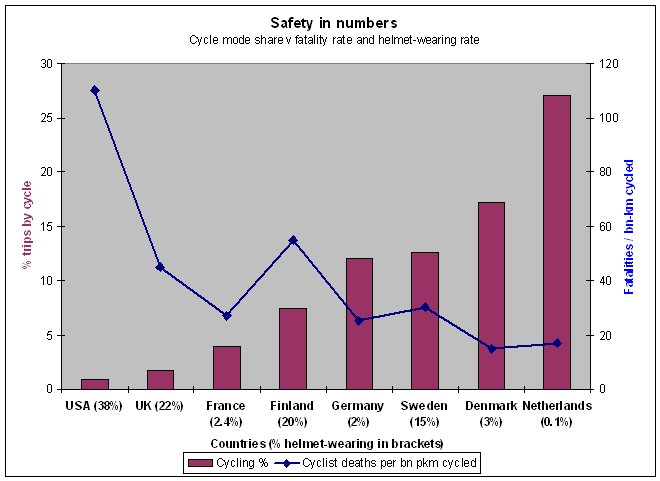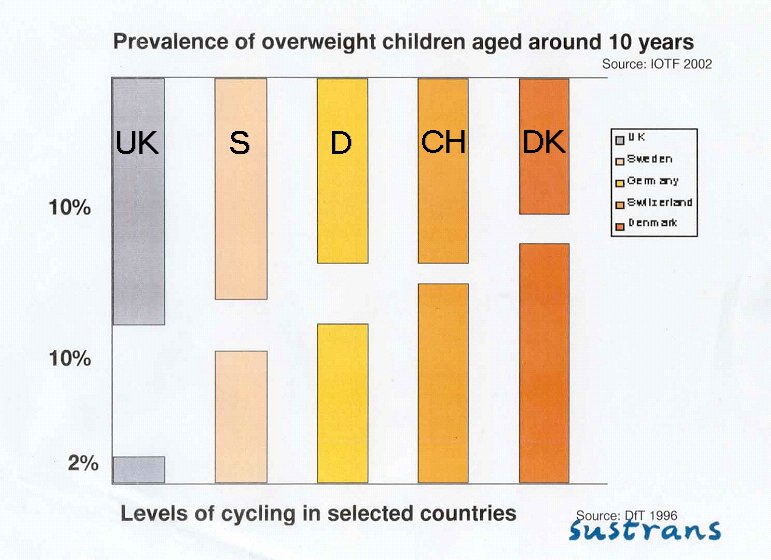Helmet use, safety and obesity
Cycle use, risk of fatality and helmet use in Europe and USA
 |
Sources
Cycle helmet wearing:
Netherlands, Denmark, Finland, Sweden (EC, 1999); Germany (Pucher and Dijkstra, 2000); UK (Bryan-Brown and Christie, 2001); USA & France (Paris) (Osberg and Stiles, 1998).
Cyclist deaths:
EU (CIT, 2001); France (Carre, 1995), USA (Pucher and Dijkstra, 2000).
Cycle Percentage of trips:
Flanders cities (ECF, 1997); USA, Canada, France, Italy, Austria (Pucher and Dijkstra, 2000); UK, Norway, Switzerland, Sweden, Denmark (EC, 1999); Germany (Bracher, 2003); Netherlands (Welleman, 2002)
|
 |
| These two graphs present alternative views of the same data |
Cycle use and obesity in Europe
There is not necessarily a direct link between these relationships. However, there are good grounds for believing that there are indirect links.
Strong cycle helmet promotion campaigns (or helmet mandation) are known to reduce cycle use (BHRF, 1020). Where cycle use is low, the risk of injury when cycling is higher due to a reduction in the 'safety in numbers' effect (Jacobsen, 2003; Wardlaw, 2002). Where cycle use is reduced, societal activity levels also decline, leading to increased average weight and obesity.
References
BHRF, 1020
How helmet promotion and laws affect cycle use. .
Bracher, 2003
Bracher T, . Nationaler Radverkehrsplan - Umsetzung in der Stadt - Einführung zur Fachtagung des Forum Mensch und Verkehr (SRL) und des Fachausschuss Verkehr (ADFC/SRL). am 23./25.5.2003 in Hannover.
Bryan-Brown and Christie, 2001
Bryan-Brown K, Christie N, 2001. Cycle helmet wearing in 1999. Transport Research Laboratory Report 487.
Carre, 1995
Carre JR, 1995. La bicyclette: un mode de deplacement meconnu dans ses risques comme dans son usage. Recherche Transports Securite Dec1995;49:19-34.
CIT, 2001
European Best Practice in the delivery of sustainable transport – Report on Stage 1: Benchmarking. Committee for Integrated Transport. WS Atkins, 2001.
DfT, 1996
Department for Transport, 1996. .
EC, 1999
How to enhance WALking and CYcliNG instead of shorter car trips and to make these modes safer. European Commission .1999.
ECF, 1997
Transport Demand of Modes not covered in International Transport Statistics. European Cyclists Federation, 1997.
IOTF, 2002
International Obesity Task Force, 2002. . 
Jacobsen, 2003
Jacobsen PL, 2003. Safety in numbers: more walkers and bicyclists, safer walking and bicycling. Injury Prevention 2003;9:205-209.
Osberg and Stiles, 1998
Osberg JS,Stiles SC, 1998. Bicycle use and Safety in Paris, Boston and Amsterdam. Transportation Quarterly 1998;52(4):61-76. 
Pucher and Dijkstra, 2000
Pucher J, Dijkstra L, 2000. Making walking and cycling safer: lessons from Europe. Transportation Quarterly Vol 54 no 3 summer 2000. 
Wardlaw, 2002
Wardlaw MJ, 2002. Assessing the actual risks faced by cyclists. Traffic Engineering + Control Dec 2002 p352-356. 
Welleman, 2002
Welleman T, . An efficient means of transport: experiences with cycling policy in the Netherlands. In Planning for Cycling, ed. Hugh McClintock, Chapter 12, pp 192-208, Woodhead Publishing Ltd, Cambridge 2002. .




